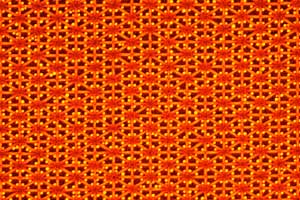| Posted: Jan 29, 2018 |
Let liquid fingers point the way
(Nanowerk News) Unlocking the molecule-detecting capabilities of gold nanoparticles often requires positioning techniques that are beyond the limits of conventional lithography. An A*STAR team now demonstrates that a combination of topographical templates and localized traps left by evaporating liquids can fabricate arrays of nanoparticles with controllable separations below five nanometers (Nanoscale, "Second order directed positioning of nanoparticles induced by the main terminal meniscus shape in irregular template cavities").
|
|
Left alone, nanoparticles tend to agglomerate due to their high entropy. Because keeping gold nanospheres set distances apart is critical for applications, including optical bioimaging, researchers are developing ways to fabricate hundreds of thousands of these objects automatically. One promising route, known as directed self-assembly, deposits liquid suspensions of reagents on to substrates with predefined small-scale patterns. Liquid capillary action then draws the nanoparticles inside the templates pushing them to their target locations.
|
 |
| A scanning electron micrograph of 8 nanometre-sized gold nanoparticles on a triangular template. (Image: A*STAR Institute of Materials Research and Engineering)
|
|
Mohamed Asbahi from the Institute of Materials Research and Engineering at A*STAR recalls trying to control self-assembly within square-shaped templates when he and his co-workers made an intriguing discovery. “We were increasing cavity sizes in the templates, and expected to see more nanoparticles inside trying to optimize their arrangement,” he says. “But with toluene as the solvent, only four nanoparticles were trapped at each corner of a square — no matter how large the cavity.”
|
|
To explain this behavior, the researchers developed a virtual model to simulate interactions between the deposited nanoparticles and solvent within confined cavities. These computations showed that after the liquid begins drying out, the shape of the retreating interface played a key role in positioning. For example, elongated liquid ‘fingers’ within square templates forced nanoparticles to move to corners where the solvent volume is the largest.
|
|
“We were surprised by this effect before we understood the physics behind it,” says Asbahi. “But after we predicted irregular cavities were more successful at directing nanoparticles than equilateral ones, we chose to validate our explanations with triangular templates.”
|
|
Working with state-of-the-art electron beam lithography, the researchers fabricated templates containing thousands of triangles just a few nanometers in scale. Comparing equilateral to right-angled triangles revealed the potential of asymmetrical patterns — up to three nanoparticles could be trapped and positioned at various nanoscale separations in right-angled templates.
|
|
Further experiments demonstrated that particular liquids can have different impacts on nanoscale patterns. While toluene tends to ‘pin’ to the template structure and trap nanoparticles at lower-than-normal densities, hexane solvents produce fully-packed surfaces. Asbahi notes that the control offered by this technique could be sufficient for integration into prefabricated circuits and plasmonic nanostructures.
|

